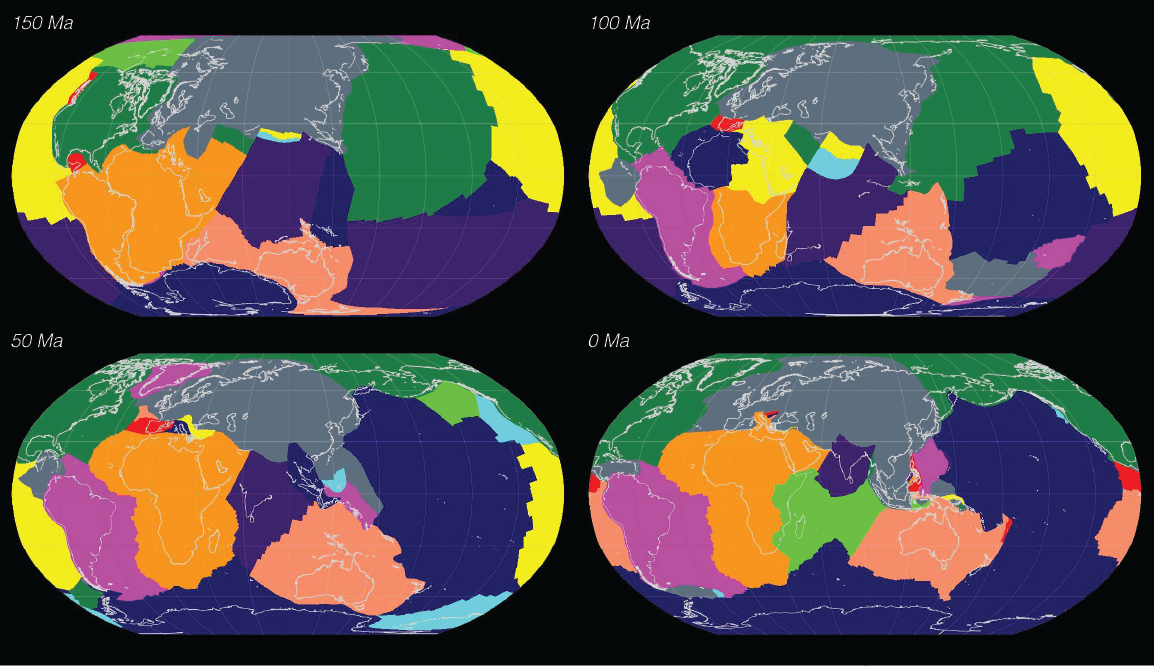
Plate tectonics drives earthquakes and volcanism, forms precious mineral deposits and controls the planet’s long-term carbon cycle. But why do we have just a few large plates, and many tiny plates? Does it matter? These questions have now been answered in a French-Swiss-Australian collaborative paper led by PhD student Claire Mallard at the Univ. Lyon, published on 15 June 2016 in the journal Nature. The paper includes Nicolas Coltice (Lyon), EarthByters Dietmar Müller and Maria Seton, and Paul Tackley (ETH).
Tectonic plates, the pieces of Earth's broken outer shell are all unequal in size. Seven plates, including the Pacific Ocean and Africa as the largest plates, account for nearly 95% of the surface. The remaining 5% is occupied by a multitude of small plates, like Iberia and the Philippine Plate, mostly along the edges of ocean basins.
The small plates are of particular interest to eastern Australia because much of the continental crust underlying Victoria, New South Wales and Queensland is made up of fragments of ancient volcanic arcs and segments of tiny “back-arc” plates that existed hundreds of millions of years ago. It’s these parts of the crust that host rich mineral deposits such as copper and gold, but the dynamic processes driving the formation and destruction of these small, ephemeral tectonic plates, is not well known.
We can think of the Earth as a giant recycling system. Spreading ridges mark those lines where tectonic plates are moving apart, leading to the rise of magma all the way to the seabed, forming new plate segments through time. Tectonic plates are destroyed at the ocean edges where they plunge into the sticky rocks of the mantle below through a process known as subduction.
The team had a hunch that the key to understanding how this recycling system produces just a few large and many small plates has to do with the stiffness of the subducting “slabs” as they descend into the viscous mantle below.
Prof. Müller said: “It’s a bit like immersing a large parmesan crostini (the subducting plate) into a thick broccoli soup (the mantle).
By letting a supercomputer simulate this process globally over geological time, the team found that the spacing between the slabs making up a network of subducting plates controls the layout of large plates. The stresses caused by the curvature of plates, as they bend to go down, break plates into smaller fragments.
Dr Seton added: “We found that the observed distribution of plate sizes is only achieved when the subducting plates have a particular stiffness, which was previously not well known. The plate fragmentation process ultimately controls the occurrence of volcanism along subduction zones, such as the present day “ring of fire” that encircles the Pacific Ocean”.
The team’s work sheds light on how the motions and fragmentation of large and small plates are connected. Some small ocean basins, called back-arc basins, like the Philippine Sea, have experienced major shake-ups in its history at the same time that the larger, neighbouring Pacific plate recorded immense changes. This is because of the heightened sensitivity of the smaller plates to the readjustment of major subduction systems.
The study opens the use of computer simulations of the solid Earth to study the last frontier of plate tectonics, which is to understand the dynamic forces that drive the motions of tectonic plates.
The paper, Subduction controls the distribution and fragmentation of Earth’s tectonic plates, can be viewed here.
You can view animations of the work below:
